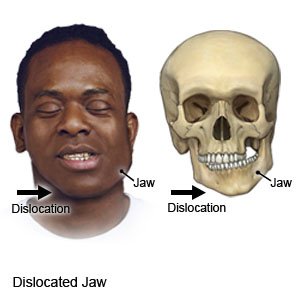Jaw Dislocation
Medically reviewed by Drugs.com. Last updated on May 6, 2024.
What is a jaw dislocation?
A jaw dislocation is the separation of your mandible (lower jaw) from your temporomandibular joint (TMJ). When this happens, your lower jaw cannot go back into place on its own. A jaw dislocation may also be called a mandibular dislocation.
 |
What are the signs and symptoms of a jaw dislocation?
- Dimpling in front of your ear
- Drooling
- Inability to open or close your mouth, or move your jaw from side to side
- Pain and swelling in front of your ear
- Teeth that do not line up
- Trouble speaking, eating, or drinking
- Unequal sides of your face
How is a jaw dislocation diagnosed?
Your healthcare provider will examine your jaw and face. He or she will ask about your other medical conditions and medicines you are taking. Tell your provider if your jawbone was dislocated before. He or she will look for signs of a jaw dislocation or other problems, such as a broken bone. You may also have any of the following:
- X-ray pictures will help your provider see TMJ and check for swelling or broken bones.
- CT scan pictures may show if your jaw is dislocated. You may be given contrast liquid before the pictures are taken to help your provider see the area better. Tell the provider if you have ever had an allergic reaction to contrast liquid.
How is a jaw dislocation treated?
- Medicines:
- Muscle relaxers help relax the muscles of your jaw.
- NSAIDs , such as ibuprofen, help decrease swelling, pain, and fever. This medicine is available with or without a doctor's order. NSAIDs can cause stomach bleeding or kidney problems in certain people. If you take blood thinner medicine, always ask your healthcare provider if NSAIDs are safe for you. Always read the medicine label and follow directions.
- Medicine may be injected into your TMJ to help tighten your jaw and prevent it from moving too much. You may need a fixation device after the shot is given.
- Fixation devices such as wires or elastic bands prevent you from moving your jaw.
- Manual reduction is a procedure to put your jaw back into its normal position. You may need a fixation device after your manual reduction.
- Surgery may be needed if other treatments do not work. Surgery may be done to tighten the ligaments around your TMJ and make it more stable.
How can I manage my symptoms?
- Support your jaw. For several days after your dislocation, try not to open your mouth widely, such as when you yawn. If you do, support your jaw. You may need a chin strap or bandage to help keep a dislocation from happening again.
- Eat soft foods. You may need to eat soft foods until your TMJ area heals. Soft foods include applesauce, baby food, bananas, cooked cereal, cottage cheese, eggs, gelatin, pudding, and yogurt.
- Apply ice to the area. Ice helps decrease swelling and pain. Ice may also help prevent tissue damage. Use an ice pack, or put crushed ice in a plastic bag. Cover it with a towel and place it over your TMJ area for 15 to 20 minutes every hour or as directed.
- Go to physical therapy, if directed. Physical therapy may be needed if you have more than one jaw dislocation. A physical therapist will work with you to help make the muscles in your jaw stronger. This may help to stop your jawbone from dislocating again.
When should I seek immediate care?
- Your jawbone moves out of place again.
When should I call my doctor?
- Your symptoms do not get better, or get worse.
- You have questions or concerns about your condition or care.
Care Agreement
You have the right to help plan your care. Learn about your health condition and how it may be treated. Discuss treatment options with your healthcare providers to decide what care you want to receive. You always have the right to refuse treatment. The above information is an educational aid only. It is not intended as medical advice for individual conditions or treatments. Talk to your doctor, nurse or pharmacist before following any medical regimen to see if it is safe and effective for you.© Copyright Merative 2024 Information is for End User's use only and may not be sold, redistributed or otherwise used for commercial purposes.
Further information
Always consult your healthcare provider to ensure the information displayed on this page applies to your personal circumstances.
